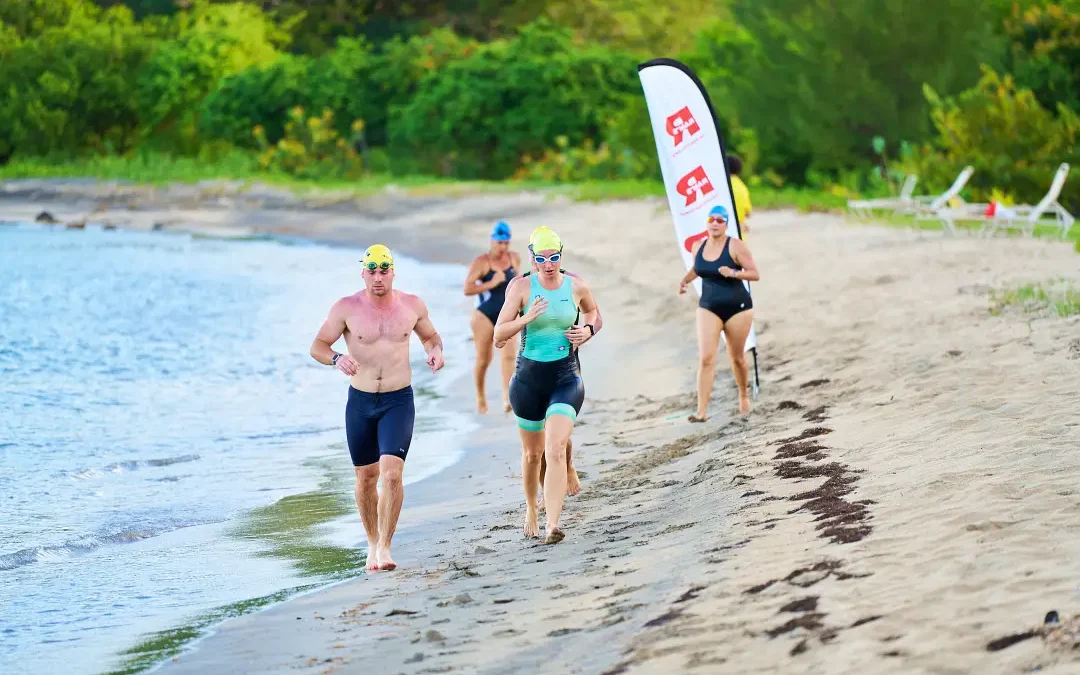With 60 days left until your triathlon in Nevis, it’s time to dial in your training. Focusing on the right workouts and preparing for race day conditions will enhance your performance. Here’s your guide to making the most of the final stretch of training.
1. Develop a Comprehensive Training Plan
Weekly Schedule: Plan a well-rounded weekly routine that includes swimming, cycling, running, strength training, and recovery. A balanced week might look like this:
- 2-3 swim sessions
- 2-3 bike rides
- 2-3 runs
- 1-2 strength training sessions
- 1-2 rest or active recovery days (such as easy swims or yoga)
Structured Phases: Divide your remaining training time into specific phases to optimize your progress:
- Build Phase (Weeks 1-4): Concentrate on building endurance by slowly increasing the volume and intensity of your workouts. Include a mix of long, steady sessions and shorter, high-intensity ones.
- Peak Phase (Weeks 5-7): Increase the intensity and focus on workouts that mimic race conditions, like brick sessions (bike-to-run transitions) and intervals at your target race pace.
- Taper Phase (Week 8): Reduce your training volume to allow recovery, but maintain some intensity to keep your fitness sharp.
2. Prepare for Nevis’s Heat and Humidity
Acclimatize to the Heat: Training for a triathlon in Nevis means getting ready for warm, humid weather. Incorporate sessions during the hottest parts of the day a few times a week to help your body adapt. This will enhance your ability to manage your body temperature during the race.
Hydration and Nutrition: Develop a hydration and nutrition plan tailored to hot conditions. Practice drinking more fluids and including electrolytes in your hydration strategy to replace the salts lost through sweating. Test different nutrition options, like gels, bars, and sports drinks, to find out what works best for you.
3. Focus on Race-Specific Training
Open Water Swimming: Practice swimming in open water to simulate race conditions in Nevis. Work on sighting, swimming straight, and managing waves or currents. If open water isn’t available, use a pool to mimic these conditions by practicing with minimal visibility or using equipment to replicate a wetsuit.
Bike Skills and Pacing: Train on varied terrain, including hills and flats, to prepare for any course profile. Practice keeping a steady effort and work on smooth transitions from biking to running.
Brick Workouts: Regularly include brick workouts (consecutive bike and run sessions) in your training. Start with shorter distances and gradually increase. This will help your body adjust to the bike-to-run transition, reducing that heavy-legged feeling when you start running.
4. Incorporate Strength and Flexibility Training
Strength Workouts: Continue strength training 1-2 times a week. Focus on exercises that build overall stability and endurance, like squats, lunges, deadlifts, planks, and core exercises. Stronger muscles will boost performance and lower the risk of injury.
Flexibility and Mobility: Add dynamic stretching to your warm-ups and static stretching or yoga to your cool-downs to maintain flexibility and prevent injuries.
5. Simulate Race Conditions
Practice Transitions: Rehearse your transitions from swim to bike (T1) and bike to run (T2). Set up a mini transition area during training sessions and practice getting out of your wetsuit (if needed), putting on your bike gear, and moving quickly to your run.
Race Nutrition Practice: During longer workouts, practice your race day nutrition strategy. Consume the same types of foods and drinks at the same intervals you plan to use on race day. This will help you understand what your body can handle and refine your nutrition plan.
6. Prepare Mentally for the Race
Visualize Success: Spend time visualizing each part of the race—swim, bike, run, and transitions. Picture yourself performing well and handling any challenges. This mental practice can build confidence and reduce race-day nerves.
Stay Focused and Positive: Concentrate on controllable factors like your pace, nutrition, and effort rather than external elements such as weather or other competitors. A positive mindset will keep you focused and help you perform at your best.
7. Taper Properly
Maintain Intensity, Reduce Volume: In the final two weeks before the race, cut your training volume by 40-60%, but keep some high-intensity efforts to stay sharp. The goal is to feel rested and ready on race day.
Prioritize Recovery: Focus on sleep, nutrition, and hydration during the taper period. Listen to your body and avoid strenuous activities that could lead to injury.
8. Final Race Day Preparations
Plan Your Travel and Logistics: Arrive in Nevis with enough time to acclimate, check out the course, and finalize your race plan. Ensure you have all your gear and know the logistics, including transition areas and course details.
Check Your Equipment: Go over all your gear, from your bike and shoes to nutrition and hydration products. Make sure everything is in working order and feels comfortable.
By following these tips and staying consistent with your training, you’ll be set to tackle your Nevis triathlon and enjoy every moment of race day. Good luck!

